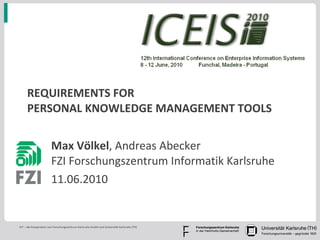REQUIREMENTS FOR PERSONAL KNOWLEDGE MANAGEMENT TOOLS
- 1. REQUIREMENTS FOR PERSONAL KNOWLEDGE MANAGEMENT TOOLS Max V├Člkel , Andreas Abecker FZI Forschungszentrum Informatik Karlsruhe 11.06.2010
- 2. Personal Knowledge Management? Why? The knowledge-based organisation is no more effective than the sum of its knowledge workersŌĆÖ effectiveness. Davenport, 2004
- 3. Personal Knowledge Management (PKM) What? PKM is a set of concepts, disciplines and tools for organizing often previously unstructured knowledge, to help individuals take responsibility for what they know and who they know European guide to good practice in knowledge management CWA 14924-1:2004 E, part 5, p. 12. European Committee for Standardization, 2004
- 4. Focus of this talk: PKM Tools Organize often previously unstructured knowledge Support personal note-taking Extend the human memory by information management Make knowledge workers more productive Many PKM tools have been built and even more tools are (ab-)used for PKM tasks. How to build a good PKM tool?
- 5. Analyze what knowledge workers do What is note-taking? Creating an external reminder (a note, a knowledge cue ) to help a person coming back to a previously experienced mental state (knowing something). What is a knowledge cue? Definition: A knowledge cue is either a piece of content , containing plain text, semi-structured text, or arbitrary binary content such as images or desktop objects, or a connection between other knowledge cues. Such connections can be unspecified relations, directed hyperlinks and formal statements.
- 10. Economic Analysis Goals: Low costs High benefit
- 11. Requirements for... (Conceptual) model vs. Tool
- 12. Req for model: Knowledge model should be a superset of existing conceptual models To reuse content residing in one kind of representation in another tool, it needs to be transformed. Convert between n formalisms? Naive: n 2 transformations Common intermediate formalism: 2n transformations Learning a new tool ’āĀ user needs to understand the conceptual model of the tool ’āĀ Formalism of good PKM tool should be similar to existing models
- 13. Req: System should run queries automatically Tool requirement
- 14. Req: Easy to learn Model and tool requirement: Seems obvious However, riding a bicycle is not easy to learn Long-term cost/benefit is relevant
- 15. What kind of notes? Model and tool requirement: Req: User decides on modeling granularity Allow very short notes Allow very long (and structured) notes Less different tools have to be used Req: Informal articulation Allow user to be informal ’āĀ lower costs (lower benefit) Req: Formal articulation Allow user to be formal ’āĀ more benefit (higher costs) Req: Simultaneous use of different levels of formality Req: Stepwise formalization
- 16. Req: Versioning Allow errors and make it easy to fix them Never loose any keystroke However, versioning and retrieval is hard
- 17. Interaction for codify and augment process Model and tool requirements: Req: Entities need to be addressable Neglected by many tools! Req: Capture the context for cue creation and import
- 18. Interaction for codify and augment process Tool requirements Req: Fast entry Otherwise knowledge model remains empty Req: Knowledge model refactoring Or model gets cluttered This includes deleting content Req: Active assistance in maintenance tasks ŌĆ£ This is older thanŌĆ”. and has been accessed less than ŌĆ” times ŌĆ”ŌĆØ ŌĆ£ This has been searched ŌĆ” times and each time it took (very long)ŌĆØ
- 19. Ways of adding structure and formality Model and tool requirements: Grouping of items Containment relationship Optional naming of knowledge cues Alternative names Order knowledge cues Linking Hierarchy Annotating content Tagging Classifying items into categories Tool requirements Simultaneous use of multiple levels of detail Source: Analysis of conceptual models of PKM tools preverbal verbal formal
- 20. Interaction for retrieval process Model and tool requirements: Queries Full-text, semantic, combined Browsing (=scanning lists) and following links Inverse relations
- 21. Expressivity Model and tool requirements: Flexible schema Structured queries Adaptation to domains Transclusion Avoid copy & paste Meta-modeling Self-describing model
- 22. List 1
- 23. List 2
- 24. Conclusions Long requirements list can be used As design specification and research agenda for PKM tool builders To assess the suitability of existing tools for PKM Core requirements: Trade-off authoring costs and retrieval value Step-wise formalization Unified knowledge model
- 25. Try http:// iMapping .info Extends listed requirements with spatial concepts Advertisement Advertisement Advertisement Advertisement Advertisement Advertisement

























